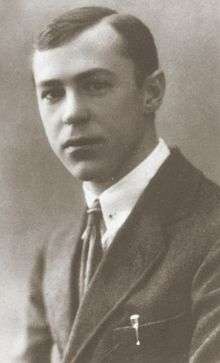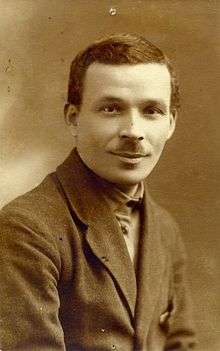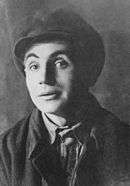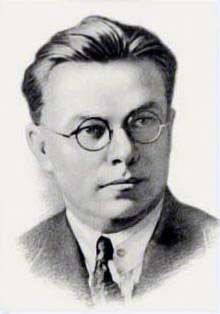Executed Renaissance

(1893-1933)

(1901-1937)

(1892-1937)

(1892-1937)

(1887-1937)

(1890-1937)
The term Executed Renaissance (Ukrainian: Розстріляне відродження, Rozstrilyane vidrodzhennya) is used to describe the generation of Ukrainian writers and artists of 1920s and early 1930s who were performing in Ukrainian Socialist Soviet Republic and were executed or repressed by Stalin's totalitarian regime. The term was firstly suggested by Polish publicist Jerzy Giedroyc in his letter to Ukrainian literature researcher Yuriy Lavrinenko who later used it as a title for the collection of the best literary works of that generation.
Background
The downfall of the Russian Empire after the First World War, the resulting abolition of imperial censorship, the establishment of an independent Ukrainian state (even if for a very short time), and the relative leniency of the Soviet regime in the 1920s all led to an astonishing renaissance of literary and cultural activity in Ukraine. Scores of new writers and poets appeared and formed dozens of literary groups that changed the face of Ukrainian literature. These processes were supported by politics of nativization (in Ukraine it was called Ukrainization), New Economic Policy (state capitalism) and elimination of illiteracy.
Literary process
Writers mostly were consolidated into literary organizations with different styles or positions. The period between 1925 and 1928 was characterized by "literature discussion" on the initiative of Mykola Khvylovy. An object of the discussion was ways of development for new Ukrainian Soviet literature and role of writer in society. Khvylovy and his associates were supporting an orientation towards Western European culture instead of Russian, they were rejecting "red graphomania" (though they weren't rejecting Communism as political ideology).
The main literary organizations of that time were:
- "Hart" (Ukrainian: Гарт which means hardening) existed in 1923-25. Its main goal was uniting of all kinds of proletarian artists with further development of proletarian culture. One of the requirements of "Hart" was using of Ukrainian language. The organization ceased to exist after its leader Vasyl Ellan-Blakytny died.[1]
- VAPLITE (Ukrainian: ВАПЛІТЕ, shortened of Free Academy of Proletarian Literature) was created in 1926 by Mykola Khvylovy on the base of "Hart". Its goal was creating of new Ukrainian literature through adopting the best achievements of Western European culture. VAPLITE was accepting Communism as political ideology but they were rejecting necessity of ideological meaning of literature as the main requirement to it. Among members of VAPLITE were Oleksandr Dovzhenko, Mykola Kulish, Les Kurbas, Mayk Johansen, Pavlo Tychyna, Oleksa Slisarenko, Mykola Bazhan, Yuriy Smolych, Yulian Shpol.[2]
- MARS (Ukrainian: МАРС, shortened of Workshop of revolutionary literature) existed in 1924-29 (primarily under name of "Lanka"). The main postulate of MARS was honestly and artistically describe that time epoch. Among its members were Valerian Pidmohylny, Hryhoriy Kosynka, Yevhen Pluzhnyk, Borys Antonenko-Davydovych, Todos Osmachka, Ivan Bahrianyi, Maria Halych.
- "Aspanfut" (Ukrainian: Аспанфут), later Komunkult (Ukrainian: Комункульт) was an organization of Ukrainian futurists. Their values were "Communism, internationalism, industrialism, rationalization, inventions, quality".[3] Among its members were Mykhayl Semenko, Heo Shkurupiy, Yuriy Yanovsky, Yulian Shpol.
- Neoclassicists (Ukrainian: Неоклясики) was a literary movement of modernists among whose followers were Mykola Zerov, Maksym Rylsky, Pavlo Fylypovych, Mykhailo Drai-Khmara. They never established a formal organization or program, but they shared cultural and esthetic interests. They were concerned with the production of high art and disdained "mass art", didactic writing, and propagandistic work.[4]
- "Pluh" (Ukrainian: Плуг which means plough) was an organization of rural writers. Their main postulate was "struggle against proprietary ideology among peasants and promoting of Proletarian revolution's ideals". Among its members were Serhiy Pylypenko, Petro Panch, Dokiya Humenna, Andriy Holovko.[5]
Repressions
In late 1920s Stalin abolished New Economic Policy and returned to forcing collectivization. In this context occurred changes in cultural politics as well. The first example of these changes was Union for the Freedom of Ukraine process in 1930, a show trial on 474 persons (mostly scientists) 15 of which were executed and 248 were sent to prison.
The main part of the campaign occurred during Great Purge in 1934-40, and especially in November 1937. In general around 223 writers were repressed.[6]
Some of important representatives of this generation survived. Part of them remained in Soviet Union (e.g. Oleksandr Dovzhenko, Pavlo Tychyna, Maksym Rylsky, Borys Antonenko-Davydovych, Ostap Vyshnya, Mykola Bazhan), others emigrated (e.g. Ulas Samchuk, George Shevelov, Ivan Bahrianyi).
Some representatives of Executed Renaissance
Boychuk, Mykhailo (30 October 1882 – 13 July 1937), artist.
Khvylovy, Mykola (13 December 1893 – 13 May 1933) prose writer and poet.
Kosynka (pseud.) Strilets, Hryhoriy (29 November 1899 – 15 December 1934), writer and translator.
Kulish, Mykola (19 December 1892 – 3 November 1937), prose writer and dramatist.
Kurbas, Oleksandr-Zenon (1887–1937), film and theater director.
Pidmohylny, Valerian (2 February 1901 – 3 November 1937), prose writer.
Polishchuk, Klym (25 November 1891 – 3 November 1937), journalist, poet and prose writer.
Starytska-Cherniakhivska, Liudmyla[7] (17 August 1868 – 1941), writer, translator and literary critic.
Yalovy, Mykhailo (5 June 1895 – 3 November 1937), poet, prosaist and dramatist.
Yohansen, Maik (Mykhailo) (pseuds: Willy Wetzelius and M. Kramar) (16 October 1895 – 27 October 1937), poet, prose writer, dramatist, translator, critic and linguist.
Svidzinsky, Volodymyr (9 October 1885 – 18 October 1941), poet and translator.
References
- ↑ Нагорний К.О. Проблема національного самоствердження в публіцистиці лідера літературного угруповання "Гарт" В. Блакитного
- ↑ Ю. Луцький. Джерела до історії Вапліте
- ↑ Quote from futurists' manifest in their magazine "Nova Generatsiya".
- ↑ Neoclassicists
- ↑ Плуг
- ↑ Юрій Лавріненко Розстріляне відродження: Антологія 1917–1933. — Київ: Смолоскип, 2004.
- ↑ Krys, Svitlana (2016) ‘Book Review: Liudmyla Starytska-Cherniakhivska, The Living Grave: A Ukrainian Legend and Klym Polishchuk, Treasure of the Ages: Ukrainian Legends’, EWJUS: East/West: Journal of Ukrainian Studies, Vol 3, No 2, pp. 213-215
Bibliography
- Юрій Лавріненко. Розстріляне відродження: Антологія 1917–1933. — Київ: Смолоскип, 2004.
- Розстріляне Відродження
- Orest Subtelny. Ukraine: A History. University of Toronto Press, 2000 - 736 p.